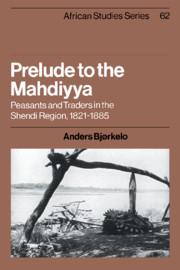Book contents
- Frontmatter
- Contents
- Figures
- List of maps
- List of tables
- Preface
- Acknowledgements
- Abbreviations
- Weights and measures
- The Sudan in the nineteenth century
- Introduction
- 1 The Ja'alī Kingdom of Shendi and its destruction
- 2 Shendi's economy on the eve of the Turkiyya
- 3 The Ja'aliyyīn under Turkish administration
- 4 The transformation of agriculture
- 5 Taxation
- 6 The transformation of commerce
- 7 Conclusion: dispersion and return
- Appendix: Three contracts from the archive of 'Abd Allāh Bey Ḥamza
- Notes
- Sources and bibliography
- Index
- OTHER BOOKS IN THE SERIES
7 - Conclusion: dispersion and return
Published online by Cambridge University Press: 31 October 2009
- Frontmatter
- Contents
- Figures
- List of maps
- List of tables
- Preface
- Acknowledgements
- Abbreviations
- Weights and measures
- The Sudan in the nineteenth century
- Introduction
- 1 The Ja'alī Kingdom of Shendi and its destruction
- 2 Shendi's economy on the eve of the Turkiyya
- 3 The Ja'aliyyīn under Turkish administration
- 4 The transformation of agriculture
- 5 Taxation
- 6 The transformation of commerce
- 7 Conclusion: dispersion and return
- Appendix: Three contracts from the archive of 'Abd Allāh Bey Ḥamza
- Notes
- Sources and bibliography
- Index
- OTHER BOOKS IN THE SERIES
Summary
EMIGRATION
A characteristic feature of Sudanese society today is the widespread settlements of northerners throughout the towns and villages of the central and southern savannas. This diaspora has pushed the frontiers of Islam further into Africa and continues to do so also today. ‘One comes across Danagla in every town in the Sudan’, wrote a diarist in 1839. From before the Turkiyya the Danagla were among the most numerous and prosperous immigrants to Kordofan, closely followed by the Ja'aliyyīn and outnumbered by them in many areas during the Turkiyya. In Kordofan, the migrants were in a somewhat freer situation, but they might still be subjected to arbitrary treatment by the Turks and be forced to move further west or south. Miiller observed an episode there in 1848 in which a peasant set fire to his house in protest after being subject to maltreatment and extortion by six soldiers; he claimed that the Turks had slaughtered his hens, stolen his sheep, driven his camels away, made a soldier out of his son, and raped his womenfolk. ‘Now you will take nothing more from me. I will go to Dar Fur!’
The sources do not indicate when this process of migration started, probably because there has always been mobility between the Nile and the savannas, and not always from the Nile. The Arabs who intermarried with the Nubians to form the Ja'aliyyīn Group may have moved into the Nile Valley from Kordofan where the founding father, Ibahim Ja'al, is said to have been buried.
- Type
- Chapter
- Information
- Prelude to the MahdiyyaPeasants and Traders in the Shendi Region, 1821–1885, pp. 137 - 147Publisher: Cambridge University PressPrint publication year: 1989



